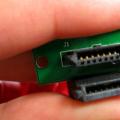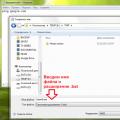An element is called a heating element washing machine, responsible for heating the water during the washing process. It is located at the bottom of the tank and fails quite often. Even a high-quality Bosch machine may need to replace the heating element, let alone such budget brands as LG, Samsung or Atlant. In this case, to replace the heater, you can call a specialist or decide to remove the old heating element with your own hands. To do this, you must first determine where the heater is located and then remove it.

How to get to the heater
The first difficulty facing washing machine owners may be access to the heater. The thing is that in some cars you can get to it through back housing, and in others - through the front panel. To easily find out where exactly the part we are looking for is located, carefully inspect the machine.

Take a look first at back surface its body - if the part that can be removed is quite large, then most likely the heating element can be reached from the back of the machine. If you find that only a small area can be removed from the back, then most likely the heater is located in the front. If in doubt, first unscrew the back cover, because this is much easier to do than dismantling the front panel.

Note that the location of the heater at the rear is typical for machines of such brands as Zanussi, Candy, Hotpoint Ariston, Indesit, Ardo and Electrolux. But manufacturers Bosch and Samsung most often place heating elements at the front. To access the heater on top-loading models, one of the side walls must be removed.
How to remove the heater
Before removing the heating element, it is important to drain the water from the machine into a previously prepared container, and also make sure that the device is disconnected from the network.
- Unscrew the required cover of the machine and find the heater.
- Disconnect the wires that go to the heating element.
- Unscrew the nut that is located in the middle, and then drive the pin that was connected to the nut inside. To do this, press it firmly or lightly tap it with a hammer.
- Having picked up the heater (use a knife or screwdriver for this), carefully remove the heating element from the tank.
- Check the functionality of the part.
You can clearly see this whole process in the video below.
Installation of heating elements
Insert the repaired or new heater into the hole and make sure that the part is in the same position as it was before removal. You want to get a tight fit. Next, holding the heating element with your hand, carefully tighten the nut. Finally, you need to return the wires to their place. Now all that remains is to turn on the test wash by selecting a program that heats the water to +600C. If the water gets hot, you can secure the removed wall and return the washing machine to its place.

How to remove it? - you ask. I'm telling you. It is necessary to release the central pin ( click on the picture - it shows schematically), which is located on the heating element itself, between the contacts. To do this, you will have to unscrew two nuts, located one on top of the other and securing the ground wire. This is a clever design. The heating element is held in place by compressing the rubber seal. The elastic band is compressed by this very pin and increases in width, covering all the cracks.
Unscrew both nuts and push the stud a little inward. Now we take pliers and strongly pull the contacts (electrodes) of the heating element. They are strong and we don’t feel sorry for them anymore. We pull one by one and swing from side to side. We remove the heating element.
3. Clean the place where the heating element sits
We remove the heating element and all the dirt from under the drum of the machine. The dirt was the cause of the problem. There will be a lot of dirt. It is important to pull it all out so that it does not interfere with the operation of the new heating element. In order to wash away all the dirt, you can first pick everything out with your long fingers, then take a bottle brush and continue with it. Then pour some water into the drum, after placing a basin in the place where the heater is removed. In short, you need to wash away everything that has accumulated there over many years.
4. Buy a new working heating element
The heater itself could also use some cleaning. With it you will go to the workshop to buy a replacement.
Finding a suitable heating element was not difficult. Take an old copy and go to the nearest washing machine repair shop. If possible, it is better to buy an original heating element rather than an analogue from China. In my case, the heating element cost 1,100 rubles.
Particular attention should be paid to:
- heating element length. It should match the length of the old one;
- electrical power. It should match the markings on the old one;
- elastic band width. This is more important than it might seem at first glance! This is especially important when selecting an analogue. If the elastic band is 1 millimeter wider, you will try to fit in something that cannot be squeezed in. If at However, then after you install it, during a hot wash, the heating element can be “spitted out” by the washing machine, no matter how hard you twist it.
Yes, little things, but our whole life consists of little things. By the way, if you find an error, highlight the word with the error and press Ctrl+Enter on your keyboard. Thank you in advance!
5. Install the heating element
Perhaps the most interesting and concise part. Installation is in the reverse order. Insert the heating element all the way, you can knock it a little. Place the nut on the stud and tighten it. Fasten the grounding, screw on the second nut. Pull the terminals onto the contacts of the heating element. Close the back cover.
That's it, you can call the washing machine testers and carry out an inspection.
Perhaps this could be the end of the description. However, I would like to note that it would not hurt to regularly clean the built-in filter. When cleaning the filter, it is a good idea to disconnect the rubber hose from the drum drain hole and rinse it thoroughly. Scale pebbles accumulate there.
That's it for a long story about quick and easy self-repair washing machine I complete. I wish you pleasant and trouble-free operation of your reliable assistant in the fight against clothing stains!
In the end, I found a video with a good demonstration of the process of replacing the heating element on a washing machine. Here is a heating element with a temperature sensor.
2018-06-20 Evgeniy Fomenko
How to change the heating element
Before replacing the heating element in the washing machine yourself, you should determine exactly where it is located. The manufacturer sometimes changes the location of the heating element, depending on the model.
So, before replacing the heating element in the Atlant washing machine, you must first carefully examine its back wall. If the model has vertical loading of laundry, then it is probably located at the very bottom, under the tank. To remove the heating element in such a machine, it will have to be turned on its side to get to the desired part.
Before starting repairs, the machine should be disconnected from electrical network so as not to work under voltage and completely drain the water. If the heater is located below or behind, you will have to disconnect the unit from the water supply.
The front or rear wall of the machine must be removed, and if the model is vertical loading, then also turned on its side and the bottom removed.
As a rule, the old heating element can be removed without difficulty. The main task is to disconnect the wires and not forget how they were connected.
To replace the heater you will need:

When replacing a heating element, it is recommended to purchase a new one, not a used one. Otherwise, most likely, you will have to repair the car again and quite soon. It is better to buy a heater of the same power and brand and change it. After the preparatory work, you can begin replacing the heating element.
To remove the heater:

Sometimes, when replacing a heater, it is necessary to use a sealant to fix it more reliably. This may be necessary if the rubber gasket is deformed, or when a used heating element is installed.
To check the correctness of the repair, you need to run a test wash at a temperature of more than 50 degrees. After ten minutes, you need to touch the hatch with your hand and if it is warm, it means that the new heating element is working.
If you have certain skills and understand the process, replacing the heater can take about an hour.
Signs of a tena malfunction
A sign of a heater malfunction is washing in cold water. That is, the machine does not heat the water. At the same time, there are situations when it is not the heating element that is to blame, but the thermostat. Therefore, it would be correct to pre-check both parts.
The heating element is a tube, inside of which there is a spiral, which, when heated from the electrical network, transfers it to the heater tube. The heater then heats the water in the drum. Due to scale, the thermal conductivity of the heater decreases, which leads to its overheating and rapid failure. Scale is a consequence of using hard water, so special attention should be paid to water treatment. When washed in soft water, the machine lasts much longer.

To ensure that the washing machine works without breakdowns, you should:
- Do not overload the drum more than the volume specified in the instructions;
- Do not close the lid hatch after washing, and give the moisture a chance to evaporate;
- Do not use hard water;
- Clean the filter periodically;
- Make sure that the car was standing straight and always on a hard surface.
If you notice that your automatic washing machine does not heat the water, then one of the likely causes of the breakdown is the failure of the heating element. In order not to pay for the work of a specialist and save money, we recommend that you replace this spare part yourself, because This is quite simple to do, having at hand a standard set of tools - wrenches and screwdrivers. In this article we will tell site readers how to replace Washing heating element DIY cars. Instructions will be provided for both rear-mounted and front-mounted models.
Step 1 — Determine the location of the heater
The first step is to decide on which side the heating element of the washing machine is located. This is quite simple to do - you need to move the case away from the wall, unfold it and inspect the back wall. If the lid is large, so to speak, the entire size, then most likely the heater is located on the back side, under the tank. In this case, the technology for replacing the heating element will be significantly simplified, because to access it you just need to unscrew the back cover of the washing machine.
If the cover is small, it means it is provided only for access to the washing machine belt, and the heating element itself is located in front, also at the bottom (as shown in the photo below). In this case, in order to replace the part, you will have to disassemble the front panel for repair, which is much more difficult and time-consuming.
Important! As a rule, for such as Candy, Whirpool, Indesit, Ariston, Electrolux, Zanussi and Atlant, the heater is located at the back. For LG, Bosch and Samsung, the heating element is often located on the front side. For top-loading washing machines, it is possible to replace the heating element through the lower part of the front panel or the side wall, which can be easily removed. However, the location does not always meet these standards. Model models are different, as they say.
Step 2 - Provide access to fasteners
When you determine where the heating element is located in the washing machine, you can proceed to disassembling the body. To do this, first of all you need to disconnect the equipment from the power supply to prevent damage electric shock when replacing the heating element. If the location is rear, you will have to additionally disconnect the drain pipe and water supply. You also cannot do without draining the remaining water from the washing machine. You can drain the water through a special drain filter or by lowering the drain hose below the level of the machine body, which can be a more problematic solution.
Next, remove the back cover. If the heating element is behind it, everything is fine, all that remains is to remove it and replace it, which we will discuss below. If you need to remove the front cover, follow these instructions:
- Remove the cover that is on top.
- Remove the detergent tray. As a rule, it is secured with self-tapping screws and additionally secured with a latch, which must be carefully removed.
- You need to remove the steel hoop from the seal on the hatch. It is held in place by a spring that just needs to be stretched a little. After removing the hoop, carefully remove the seal itself, as well as the door lock from which you need to disconnect the wires.
- After this, you can unscrew the front panel, which is secured with self-tapping screws and possibly clips.
- Access to replace the heating element is provided, you can proceed to the main process.
Step 3 - Change the heating element
So, all that remains is to replace the heating element in the washing machine yourself. It's not difficult, because... The heater is held in place by only one nut. Before unscrewing this nut (1), you need to disconnect the power terminals, grounding and wires from the temperature sensor.

In order not to confuse anything after replacement, we recommend that you initially take a photo of how everything is connected.

To unscrew the nut that holds the heating element, it is best to use a socket wrench. If this is not the case, carob will do. We unscrew the nut almost to the end, then press the pin (2) inward, which will allow you to remove the part from the seat. Then unscrew the nut completely and, loosening the heating element to the sides, carefully pull it out.

Before you start replacing the heating element of your washing machine, we recommend that you check it again. The verification method is shown in the video below:
How to check the performance of the heater
If the heater really fails, it needs to be replaced with a new one. How to change the heating element washing machine at home, the master says in a video lesson:
Master class on replacing the heating element
Assembly is carried out in the reverse order, but before this you need to clean the compartment for placing the heating element from powder and excess debris. To prevent leakage, you can additionally seal the new heater with sealant. But if the dismantling of the old product was carried out carefully and the mounting socket is not damaged, there will be no leaks. We connect the wires, screw on the back cover and check whether the water heats up when the wash is turned on.
That, in fact, is the whole technology for replacing a failed heating element. As you can see, you can replace the heating element of a washing machine with your own hands and do it quite simply!
You probably don't know:
Do stains remain on things after washing? Does your laundry smell musty? Your machine probably washes with cold water. This happens when the tubular heater breaks down. How to replace the heating element in a washing machine so that the repair is quick and effective? We will reveal all the secrets of independently checking and replacing the heater.
Where is the heating element in the washing machine? Causes of failure
The location of the element may differ depending on the brand of washer. Presumably, in the Ariston, Ardo, Candy, Indesit, Electrolux, and Zanussi models, the part is hidden behind the rear panel. But in SMA AEG, Beko, Bosch, Siemens, Samsung, Whirlpool, the heating element is most often located behind the front cover.
In the Hansa machine you can get the heater through the base panel.
Not sure where to look for a part? Then inspect the SMA body. If the back cover is solid, then the heater is there. If it's small, you should look behind the front wall. The problem is that dismantling it is troublesome. Therefore, it is easier to look behind the back cover.

The service life of the heating element is influenced by the following factors:
- Hard water.
- Voltage fluctuations in the network.
A multimeter tester will help you accurately determine whether the heating element needs to be replaced. But there are also indirect signs that indicate a problem:
- The powder granules do not dissolve well, leaving traces of detergent on the laundry.
- When you place your palm on the glass of the sunroof 15–20 minutes after the start of the heating program, you will feel that it turns out to be cold.
An error code may appear on the machine's display.
Before changing a part, prepare a replacement element. Selected individually for each SM model. You will also need a socket wrench, a screwdriver and liquid soap.
Replacing the TENA spiral with your own hands
Did you find out where the element is? Now start disassembling the case. Before starting work, disconnect the equipment from the mains and close the inlet valve. It is advisable to drain the remaining water so that when the machine is tilted, it does not get on the parts.
- Open the lower hatch (panel).
- Place the container.
- Unscrew the filter.

- Wait for the water to drain.
Before removing the heating element from the washing machine, remove the panel.
- Remove the mounting screws from the back to remove the top cover.
- Unscrew the bolts around the perimeter of the rear panel. Put it aside.
To remove the outer wall:
- Remove the dispenser tray from the housing.
- Open the loading door.
- Bend down the hatch cuffs.
- Use a screwdriver to hook the clamp and remove it.

- Remove the screws around the perimeter.
- Pull the wall up and remove.

Access is open. Now let's move on to how to remove and install the heating element in the washing machine.
- The part is located under the tank in a round-shaped mounting hole.
- Disconnect the power cables.
- To confirm if a part is broken, take a multimeter.
- Set the toggle switch to resistance measurement mode.
- Place the probes on the contacts.

- A working element will show values from 20 to 30 ohms.
- The product is fixed in the socket using a pressure plate. How to get it out? To do this, twist the central nut (not all the way). Push the bolt inward. Pry the base slightly with a screwdriver. Before pulling out and replacing the heating element, monitor the condition of the seal. It is advisable not to damage it when removing it.

- After dismantling is completed, inspect the mounting hole. Remove dirt and debris.
How to insert the heating element into place:
- Screw the nut onto the heater bolt.
- Insert it into the hole.

You can make installation of the heating element easier by lubricating the seal with liquid soap or detergent. Then the part will fit into the socket more easily and sit down.
After fixing the heater with a clamping nut, the wiring is connected to it. Connecting the heating element is carried out in the reverse order. Once the work is completed, run a test wash at at least 50 degrees. Make sure the water is heating and there are no seal leaks.
The work is shown in the video.




